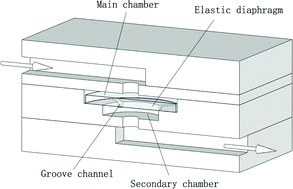Converting steady laminar flow to oscillatory flow through a hydroelasticity approach at microscales†
Abstract
We report a hydroelasticity-based microfluidic oscillator that converts otherwise steady laminar flow to oscillatory flow. It incorporates an elastic diaphragm to enhance nonlinearity of the flow. Negative differential flow resistance is observed. High-frequency oscillatory flow is produced passively through interactions among hydrodynamic, elastic and inertial forces, without resorting to external actuators and control equipment. Driven by fluid flow and pressure, this device can operate in either steady laminar flow or oscillatory flow states, or work as a valve. Its applications for flow control and operation, and


 Please wait while we load your content...
Please wait while we load your content...